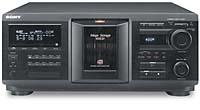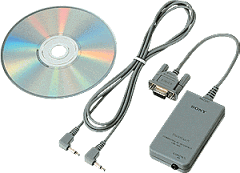
 |
| The Sony CDP-CX400 |
| January 15, 2003: Please see the new FAQ list, along with our new pages on obtaining hardware and assembling cables. |
My wife asked me what I wanted for our fifth anniversary. “I don’t know,” I said, “but if it’s something electronic, please make it Sony.” A couple of weeks later, I unwrapped a 400-disc CD changer. Sweet! I slid it into the armoire we hide our electronics in and started loading CD’s into it. Around the hundredth disc I wondered aloud how I’d be able to tell which CD was in which slot.
“Did you put the cases in the same order as the CD’s?” my wife asked. She’s smarter than I am.
“Nope,” I replied, staring morosely at the jewel cases littering the living room floor, “but they’re in sort of alphabetical order.”
“That doesn’t make any sense. They should be sorted by what kind of music they are. Why can’t I just push a button to play all of my country CD’s?”
“Hmmmmmmmmmmmmm,” I answered. “There are ports on the back that communicate with other Sony gadgets, and there are CD databases on the web that tell you what genres a CD belongs in...I bet there’s a product that does what you want.”
To make a long story short, there were no products that did exactly what we wanted. I'm a software developer by profession, so I wrote my own. Now I'm making it available to other Sony jukebox owners.
Use the links at the left to learn more about CDPrimate or to visit the purchase and support pages. If you'd like to learn more about why I wrote CDPrimate, keep reading.
The ports on the back were labeled “Control A-1.” The manual that came with the changer said the ports used a cable with 1/8-inch monoaural plugs, and that devices could be chained together. I bought the cable at Radio Shack the next day on my lunch break. I spent that evening looking for ways to communicate with the CD changer. The king of the hill seemed to be a device called the Slink-E , from a company called Nirvis Systems, Inc. It looked like overkill for what I wanted to do; the Slink-E is designed for home automation applications, so it has a lot of features I didn’t need. Plus it cost as much as the CD changer did.
A bunch of Linux® guys (like this one) used a homebuilt parallel port interface to communicate with Control-A1 devices, but I wanted to be able to use my Windows laptop to control the changer. No problem, I figured, there had to be lots of ways to talk to a Windows parallel port. I went back to Radio Shack for ten dollars' worth of parts. My wife was kind enough to build the interface for me (she's better at hardware than I am) and pretty soon I was able to communicate with the CD changer through one of my Linux boxes. I found a great source for parallel port developers and downloaded some of the Windows parallel port drivers. I found a couple of problems, though. First, it was really difficult to find a single device driver that would work on Windows 95, 98, NT, ME, 2000, and XP. Second, the driver I liked the best caused VCOMM , the Windows 95/98/ME serial and parallel port driver, to crash about one out of every four times.
OK, I'd have to write my own device driver. I bought a book on Microsoft's new device driver architecture and started studying. It looked to me as though the differences in the device models of Windows 95, 98, NT, ME, 2000, and XP were going to force me to write at least three different drivers: one in assembly (or a VxD) for 95 and 98, one using the NT model, and one using the new WDM model. That did not sound fun at all. I wanted to build an application, not a family of device drivers. I found a pretty good driver development kit that plugged into Microsoft Visual Studio, but it cost about $800.
 |
| The Sony PCLK-MD1 |
It looked as though I'd have to write my own code after all. I decided to write my application in Java, because it was my favorite language. I could use Sun's JavaCOMM API to talk with the PCLK-MD1. I found a great site for Control A-1 hackers and started deciphering the mysteries of Sony consumer electronics.